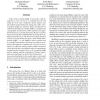Free Online Productivity Tools
i2Speak
i2Symbol
i2OCR
iTex2Img
iWeb2Print
iWeb2Shot
i2Type
iPdf2Split
iPdf2Merge
i2Bopomofo
i2Arabic
i2Style
i2Image
i2PDF
iLatex2Rtf
Sci2ools
FOCS
2004
IEEE
2004
IEEE
Shuffling by Semi-Random Transpositions
In the cyclic-to-random shuffle, we are given n cards arranged in a circle. At step k, we exchange the k'th card along the circle with a uniformly chosen random card. The problem of determining the mixing time of the cyclicto-random shuffle was raised by Aldous and Diaconis in 1986. Recently, Mironov used this shuffle as a model for the cryptographic system known as RC4, and proved an upper bound of O(n log n) for the mixing time. We prove a matching lower bound, thus establishing that the mixing time is indeed of order (n log n). We also prove an upper bound of O(n log n) for the mixing time of any "semi-random transposition shuffle", i.e., any shuffle in which a random card is exchanged with another card chosen according to an arbitrary (deterministic or random) rule. To prove our lower bound, we exhibit an explicit complex-valued test function which typically takes very different values for permutations arising from few iterations of the cyclic-to-random-shuffle and ...
| Added | 20 Aug 2010 |
| Updated | 20 Aug 2010 |
| Type | Conference |
| Year | 2004 |
| Where | FOCS |
| Authors | Elchanan Mossel, Yuval Peres, Alistair Sinclair |
Comments (0)

